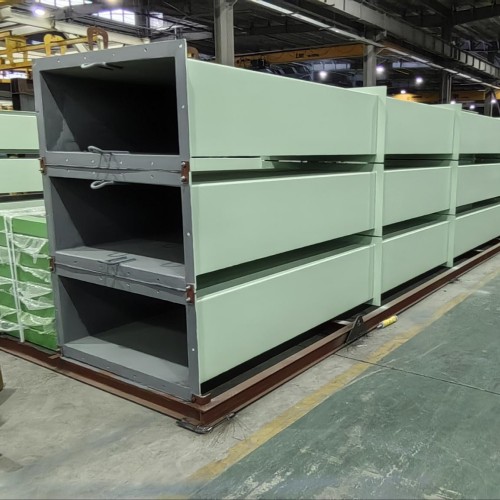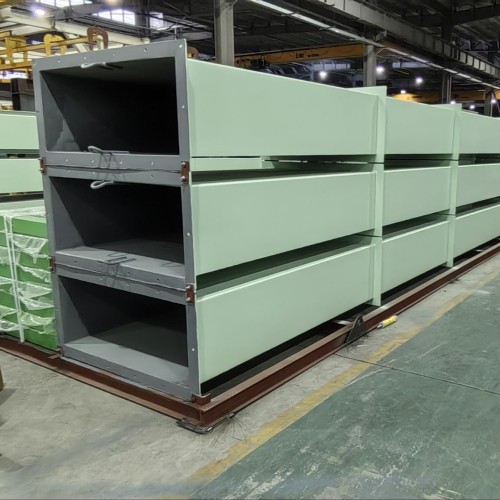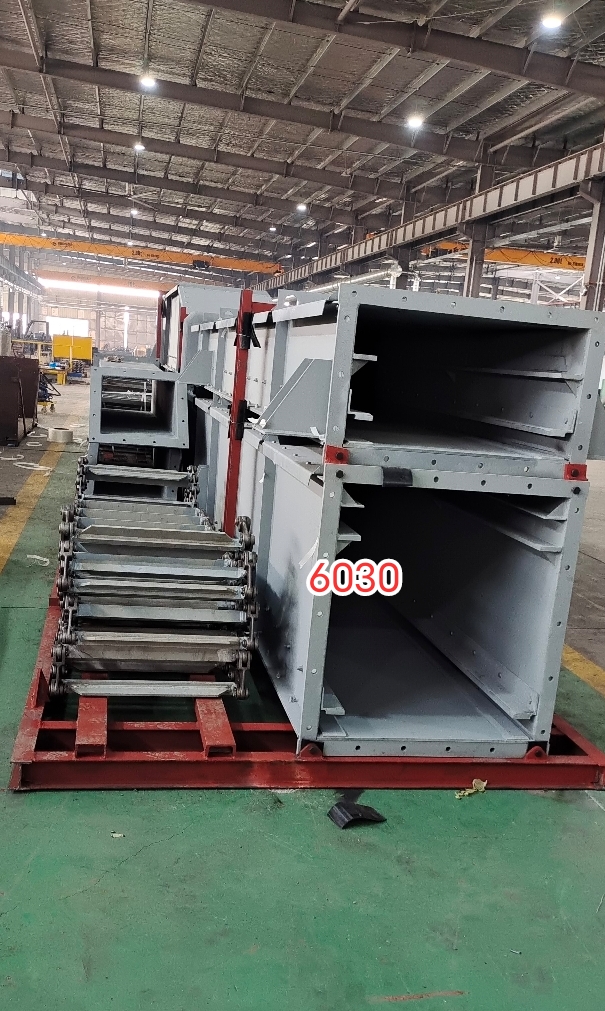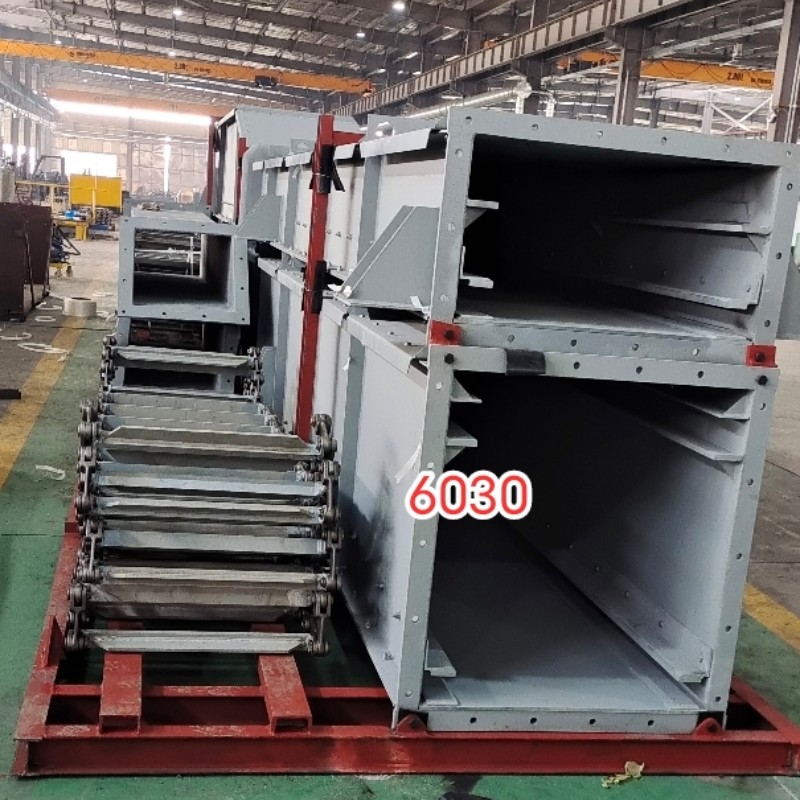
Submerged Conveyor for Bottom Ash Handling
Submerged Grind Conveyor for Bottom Ash Handling
A Submerged Grind Conveyor (SGC) is a specialized system used in power plants, particularly in coal-fired and waste-to-energy plants, for bottom ash handling. It is designed to efficiently transport and process bottom ash after it has been removed from the boiler or combustion chamber. The submerged grind conveyor system provides several advantages, particularly in terms of cooling, grinding, and safe handling of bottom ash, which typically consists of large, heavy, and often hot particles.
Key Features of Submerged Grind Conveyors
- Water-Cooled Design:
- The submerged grind conveyor operates beneath the surface of water, where the bottom ash is cooled as it moves along the conveyor. This helps mitigate heat, suppress dust, and reduces the risk of fire hazards.
- Ash Grinding Functionality:
- Unlike conventional submerged conveyors, the grind component of the SGC means that larger ash particles are ground into smaller, more manageable sizes during transport. This is done using a grind wheel or hammer mill that is integrated into the conveyor system.
- High-Temperature Resistance:
- The system is built to withstand the high temperatures associated with freshly discharged bottom ash. The submerged design keeps the ash cool and prevents overheating, reducing wear on the conveyor components.
- Continuous and Efficient Operation:
- Submerged grind conveyors are designed to run continuously, offering efficient and reliable transport of bottom ash from the boiler to a discharge or disposal point.
- Corrosion and Wear-Resistant Materials:
- Components like the conveyor chain, flights, and grinding elements are made of durable, corrosion-resistant materials (e.g., stainless steel or high-strength alloys) to withstand the harsh conditions of bottom ash handling.
- Compact and Flexible Design:
- The system can be tailored to fit different plant layouts. It can handle ash transport over varying distances and heights, either horizontally or inclined.
Working Principle of Submerged Grind Conveyors
- Ash Collection:
- Bottom ash is first collected from the boiler or combustion chamber. In some designs, a water seal or slag tap helps direct the ash into the submerged grind conveyor system.
- Submerged Transport:
- The ash flows into the submerged trough, which is filled with water. The conveyor chain, which has integrated grinding mechanisms (such as grind wheels or hammer mills), moves the ash along the trough, cooling it in the process.
- Grinding Process:
- As the ash moves along the conveyor, it passes through the grinding section, where larger particles are crushed or ground into smaller, more uniform sizes. This improves handling and processing of the ash downstream.
- Ash Discharge:
- Once the bottom ash reaches the end of the conveyor, it is discharged into a cooling pit, storage hopper, or other disposal areas. The finely ground ash can then be further processed or transported for disposal.
- Water Circulation:
- The water in the submerged trough is continuously circulated or replenished to maintain the proper cooling and dust suppression functions. It also ensures that the grind process operates efficiently without excessive wear on the system.
Advantages of Submerged Grind Conveyors
- Dust-Free Operation:
- The submerged design eliminates airborne dust by keeping the ash under water, making the system safer for workers and more environmentally friendly by reducing emissions of ash dust.
- Efficient Cooling:
- The water-cooling mechanism helps maintain a safe operating temperature for both the ash and the conveyor system, preventing overheating and potential damage to components.
- Size Reduction for Easier Handling:
- The grinding feature of the submerged grind conveyor helps reduce the size of the bottom ash, making it easier to handle, transport, and dispose of. Smaller particles also reduce the risk of blockages in downstream equipment.
- Improved Ash Processing:
- By grinding the ash, the system makes it more suitable for further processing or utilization, such as in cement production, reducing the overall volume and making it more manageable.
- Reduced Maintenance:
- The submerged environment helps reduce the wear on the system’s components by preventing direct exposure to the abrasive ash. The water-cooling feature also helps extend the life of critical parts like chains, flights, and grinding mechanisms.
- Continuous and Reliable Operation:
- The system is designed to operate continuously without frequent downtime, ensuring that ash removal and handling can be maintained 24/7, which is critical for power plants and waste-to-energy facilities.
Components of a Submerged Grind Conveyor System
- Submerged Trough:
- A water-filled channel that transports the ash. It also provides a containment area to cool and suppress the dust from the hot ash.
- Chain and Flight System:
- A series of durable chains and flights (or paddles) move the ash along the submerged trough. The flights also help to keep the ash moving and in contact with the grinding mechanism.
- Grinding Mechanism:
- This is the critical element of the submerged grind conveyor. It is typically a grind wheel or hammer mill integrated into the conveyor that grinds large ash particles into finer particles for easier handling and disposal.
- Drive and Tensioning Mechanism:
- A motor or drive unit powers the conveyor chain and grinding system. The tensioning system ensures that the chain maintains the proper tension to avoid slippage or overstretching.
- Water Circulation System:
- The water circulating system ensures the trough stays filled with water, helping to cool the ash, suppress dust, and maintain the grinding process.
- Ash Discharge System:
- At the end of the conveyor, a discharge mechanism releases the processed ash into a designated collection area, typically a storage hopper, cooling pit, or disposal system.
- Inspection and Maintenance Ports:
- Ports are provided for inspection and maintenance purposes, ensuring that the system can be easily cleaned and maintained to prevent operational issues.
Applications of Submerged Grind Conveyors
- Coal-Fired Power Plants:
- Bottom ash generated during the combustion of coal is processed by the submerged grind conveyor. It is often used in these plants due to the high volume and temperature of ash produced.
- Waste-to-Energy Plants:
- In waste-to-energy plants, submerged grind conveyors handle bottom ash created from the incineration of municipal solid waste, ensuring safe cooling, grinding, and transport.
- Cement Production:
- The finely ground bottom ash from submerged grind conveyors can be used as a supplementary material in cement production, as it has properties that improve the strength and durability of cement.
- Steel and Metallurgical Plants:
- Metallurgical plants may use submerged grind conveyors to process and handle slag and other byproducts produced during metal smelting.
- Incineration Facilities:
- Submerged grind conveyors are also used in incineration facilities to handle the bottom ash produced by burning waste, ensuring efficient processing and safe disposal.
Maintenance Considerations
- Water Quality Management:
- The water used in the submerged trough should be regularly checked for contaminants or debris that may clog the system. Filters and water circulation systems should be maintained for optimal performance.
- Wear and Tear of Components:
- Regular inspection of the grind mechanism, chains, flights, and other moving parts is necessary to prevent wear. The grinding mechanism may require periodic maintenance or replacement, especially after extended use.
- Grinding Element Replacement:
- Over time, the grinding elements (such as grind wheels or hammers) will wear down. Regular replacement is required to maintain optimal grinding performance.
- Routine Cleaning and Lubrication:
- As with any conveyor system, regular cleaning and lubrication of the moving parts are required to ensure smooth and efficient operation.
Comparison with Other Ash Handling Systems
| Feature | Submerged Grind Conveyor | Dry Ash Handling Conveyor | Pneumatic Ash Conveyor |
|---|---|---|---|
| Temperature Resistance | Very high (water-cooled) | Moderate | Low |
| Dust Control | Excellent (fully submerged) | Moderate | Excellent (if enclosed) |
| Wear Resistance | High (due to water-cooling) | Moderate to high | Moderate |
| Energy Efficiency | Moderate to high (water cooling) | High | Low |
| Size Reduction | Yes (grinds large particles) | No | No |
| Maintenance Needs | Low (water cooling extends life) | Moderate to high | High |
Why Choose a Submerged Grind Conveyor for Bottom Ash Handling?
- Safe and Dust-Free Operation:
- The submerged design eliminates airborne ash dust, ensuring a safer working environment.
- Effective Size Reduction:
- The grinding mechanism ensures that the bottom ash is processed into smaller, more manageable particles.
- Continuous and Reliable Operation:
- Designed for 24/7 operation, the submerged grind conveyor ensures continuous ash handling with minimal downtime.
- Durability and Low Maintenance:
- The water-cooling system helps reduce wear, leading to lower maintenance costs and extended service life for the system.
- Environmental and Regulatory Compliance:
- The dust suppression and cooling features of the system help meet environmental regulations regarding air quality and waste handling.
If you need more information on the design, components, or specifications of a Submerged Grind Conveyor, feel free to ask, and I can assist with further details!
Write your message here and send it to us






